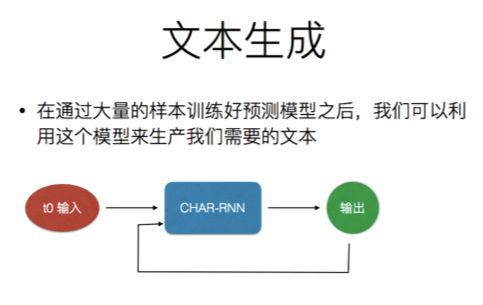RNN 通过字符语言模型 理解BPTT
链接:https://github.com/karpathy/char-rnn
http://karpathy.github.io/2015/05/21/rnn-effectiveness/
https://github.com/Teaonly/beginlearning/tree/master/july


""" Minimal character-level Vanilla RNN model. Written by Andrej Karpathy (@karpathy) BSD License """ import numpy as np # data I/O data = open('input.txt', 'r').read() # should be simple plain text file chars = list(set(data)) data_size, vocab_size = len(data), len(chars) print 'data has %d characters, %d unique.' % (data_size, vocab_size) char_to_ix = { ch:i for i,ch in enumerate(chars) } ix_to_char = { i:ch for i,ch in enumerate(chars) } # hyperparameters hidden_size = 100 # size of hidden layer of neurons seq_length = 25 # number of steps to unroll the RNN for learning_rate = 1e-1 # model parameters Wxh = np.random.randn(hidden_size, vocab_size)*0.01 # input to hidden Whh = np.random.randn(hidden_size, hidden_size)*0.01 # hidden to hidden Why = np.random.randn(vocab_size, hidden_size)*0.01 # hidden to output bh = np.zeros((hidden_size, 1)) # hidden bias by = np.zeros((vocab_size, 1)) # output bias def lossFun(inputs, targets, hprev): """ inputs,targets are both list of integers. hprev is Hx1 array of initial hidden state returns the loss, gradients on model parameters, and last hidden state """ xs, hs, ys, ps = {}, {}, {}, {} hs[-1] = np.copy(hprev) loss = 0 # forward pass for t in xrange(len(inputs)): xs[t] = np.zeros((vocab_size,1)) # encode in 1-of-k representation xs[t][inputs[t]] = 1 hs[t] = np.tanh(np.dot(Wxh, xs[t]) + np.dot(Whh, hs[t-1]) + bh) # hidden state ys[t] = np.dot(Why, hs[t]) + by # unnormalized log probabilities for next chars ps[t] = np.exp(ys[t]) / np.sum(np.exp(ys[t])) # probabilities for next chars loss += -np.log(ps[t][targets[t],0]) # softmax (cross-entropy loss) # backward pass: compute gradients going backwards dWxh, dWhh, dWhy = np.zeros_like(Wxh), np.zeros_like(Whh), np.zeros_like(Why) dbh, dby = np.zeros_like(bh), np.zeros_like(by) dhnext = np.zeros_like(hs[0]) for t in reversed(xrange(len(inputs))): dy = np.copy(ps[t]) dy[targets[t]] -= 1 # backprop into y. see http://cs231n.github.io/neural-networks-case-study/#grad if confused here dWhy += np.dot(dy, hs[t].T) dby += dy dh = np.dot(Why.T, dy) + dhnext # backprop into h dhraw = (1 - hs[t] * hs[t]) * dh # backprop through tanh nonlinearity dbh += dhraw dWxh += np.dot(dhraw, xs[t].T) dWhh += np.dot(dhraw, hs[t-1].T) dhnext = np.dot(Whh.T, dhraw) for dparam in [dWxh, dWhh, dWhy, dbh, dby]: np.clip(dparam, -5, 5, out=dparam) # clip to mitigate exploding gradients return loss, dWxh, dWhh, dWhy, dbh, dby, hs[len(inputs)-1] def sample(h, seed_ix, n): """ sample a sequence of integers from the model h is memory state, seed_ix is seed letter for first time step """ x = np.zeros((vocab_size, 1)) x[seed_ix] = 1 ixes = [] for t in xrange(n): h = np.tanh(np.dot(Wxh, x) + np.dot(Whh, h) + bh) y = np.dot(Why, h) + by p = np.exp(y) / np.sum(np.exp(y)) ix = np.random.choice(range(vocab_size), p=p.ravel()) x = np.zeros((vocab_size, 1)) x[ix] = 1 ixes.append(ix) return ixes n, p = 0, 0 mWxh, mWhh, mWhy = np.zeros_like(Wxh), np.zeros_like(Whh), np.zeros_like(Why) mbh, mby = np.zeros_like(bh), np.zeros_like(by) # memory variables for Adagrad smooth_loss = -np.log(1.0/vocab_size)*seq_length # loss at iteration 0 while True: # prepare inputs (we're sweeping from left to right in steps seq_length long) if p+seq_length+1 >= len(data) or n == 0: hprev = np.zeros((hidden_size,1)) # reset RNN memory p = 0 # go from start of data inputs = [char_to_ix[ch] for ch in data[p:p+seq_length]] targets = [char_to_ix[ch] for ch in data[p+1:p+seq_length+1]] # sample from the model now and then if n % 100 == 0: sample_ix = sample(hprev, inputs[0], 200) txt = ''.join(ix_to_char[ix] for ix in sample_ix) print '----\n %s \n----' % (txt, ) # forward seq_length characters through the net and fetch gradient loss, dWxh, dWhh, dWhy, dbh, dby, hprev = lossFun(inputs, targets, hprev) smooth_loss = smooth_loss * 0.999 + loss * 0.001 if n % 100 == 0: print 'iter %d, loss: %f' % (n, smooth_loss) # print progress # perform parameter update with Adagrad for param, dparam, mem in zip([Wxh, Whh, Why, bh, by], [dWxh, dWhh, dWhy, dbh, dby], [mWxh, mWhh, mWhy, mbh, mby]): mem += dparam * dparam param += -learning_rate * dparam / np.sqrt(mem + 1e-8) # adagrad update p += seq_length # move data pointer n += 1 # iteration counter




 浙公网安备 33010602011771号
浙公网安备 33010602011771号